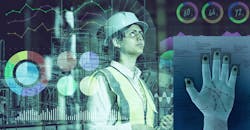Factory Efficiency, Performance, and Quality Relies on Industrial Sensors
Download this article in PDF format.
I’m not telling you anything don’t already know: The modern factory or other production facility could not function without the ability to sense its surroundings and the status of its critical equipment. And that all is made possible, of course, due to sensors. These devices measure critical physical characteristics and provide inputs to computers, PLCs, machine tools, other equipment, and networks. The outputs of these sensors determine the overall function and outcome of the factory processes. Their importance cannot be overstated.
So, the questions that inevitably loom are: “What are you doing to improve factory processes or facilities?” And, “what’s the state of your sensor responsibilities?”
If you’re working in a factory that’s implementing Industry 4.0 solutions, designing IoT systems including industrial IoT products, providing telemetry at a remote pipeline site, or developing equipment to be used in industry, you may want to take a look at some of the latest sensor trends. Then review the available types and see how they can contribute some improvements.
Before getting into the ins and outs of sensors, we need to talk about transducers versus sensors. There’s sometimes confusion between a sensor and transducer, and the roles they play.
Sponsored Resources:
- TE Conectivity enables the modernization of industrial applications
- TE Connectivity has depth and scale of our sensors portfolio
- Temperature Sensors
What’s the Difference Between a Sensor and a Transducer?
The terms sensor and transducer are often used interchangeability. That’s not exactly correct. The detailed definitions of each term indicate some difference. In this article, we define the sensor as a device that converts some physical quantity into an electrical signal that can be captured and measured.
A transducer is a device that converts one form of energy to another form of energy. That broad definition means that a sensor is some kind of transducer. However, a transducer includes a broader range of devices. A solar cell is a transducer that converts light energy into a voltage. A motor is a kind of transducer that translates electrical energy into mechanical energy.
An interesting example of a transducer is an antenna. Yes, it’s true. An antenna for wireless devices converts an electronic voltage into electromagnetic waves that radiate to distant points. But the antenna also translates the received electromagnetic waves back into an electrical signal.
Sensor Trends
Over the years, several relevant sensor trends have emerged. First, sensor accuracy continues to improve. Second, more different types of sensors are available. Third, more digital sensors are available—digital output sensors permit more direct input to computers and other equipment. Fourth, sensors are continually and increasingly being embedded into more equipment and buildings to increase efficiency and quality. Improved sensors enable the modernization of industrial applications. Are you and your industrial equipment on-trend?
Review of Sensor Types
Sensors are categorized in several ways. Examples are analog vs. digital, physical characteristic measured, passive or active, and industry application.
Physical Parameters
Sensors measure the following:
- Temperature
- Pressure
- Photo/Optical
- Position/Proximity
- Speed
- Fluid flow
- Humidity
- Vibration/Force/Torque
Analog vs. Digital
Physical attributes are analog variables. They vary continuously over time. The sensor converts that variation into a voltage or current signal. But depending on the variable and the transducer, that signal often needs signal conditioning, such as amplification, filtering, compensation, or linearization, before it can be used. An electronic signal conditioning circuit makes this signal ready for capture, display, or control. Common analog output signals are 0 to 5 V and 4 to 20 mA.
Digital sensors produce a serial digital output. These are typically analog sensors with signal conditioning. The signal is sent to an analog-to-digital converter (ADC), where it’s digitized and transmitted to the targeted device. The most common interface is the I2C, a popular standard in industry. These sensors have outputs that are directly prepared for use by a computer, PLC, or other digital device.
Sensor Specifications
As you’re selecting a new sensor or a replacement for an existing sensor, you should be concerned with these specifications:
- Range: This is the breadth of measurement capability. The upper and lower limits of the quantity to be measured.
- Accuracy: Accuracy is a quantity that’s a measure of how close a measured value is to the true value: %Accuracy = (Measured/True) × 100. For sensors, the accuracy is expressed in terms of percentage of the full-scale (FS) output. (e.g., ±0.25% FS).
- Resolution: This is smallest increment in change in a quantity that can be distinguished. It’s undefined for an analog value since it’s a continuous signal. With digital sensors, resolution is expressed as the resolution of the ADC expressed in the number of bits.
- Output: An analog voltage or current for analog sensors or a serial digital bit stream with logic levels defined for digital sensors.
- Interface to equipment: Is signal conditioning included in the sensor or are external circuits required? For digital sensors, what standard is used? Wireless? Bluetooth, Wi-Fi, etc.? Wired? I2C, etc.
- Power: Source of dc power for the sensor and its circuitry. Batteries, internal ac-dc power supply, dc-dc converter, external ac-dc conversion.
Your Sensor Status
Here’s a checklist of questions to determine your present inventory of deployed sensors:
- Is every quantity you need to know about currently being measured?
- Is there any one quantity not currently monitored that would help productivity or provide other benefits?
- If you could monitor anything, cost not an objection, what would it be?
- Do you have any sensors that seem to be giving deviant readings that should be calibrated or replaced?
- Are there any defective sensors that should be changed out with new and better sensors?
- Would switching from analog sensors to digital sensors provide any improvements?
- Do you have a stock of replacement sensors that can be immediately tapped if a critical sensor fails?
- Do you have multiple sensor vendors or just one?
- Are there any instances that would provide extra benefit if sensors were embedded into existing equipment?
Where to Get the Sensors You Need
TE Connectivity offers a sensor product line with both depth and scale. TE's portfolio of analog and digital output sensors supports existing applications as well as new and growing applications. For example, factory equipment and infrastructure applications dominate, but many new products are targeted at the smart-home market. A growing category is sensors designed for embedding in other devices.
The best way to get familiar with this extensive product line is to identify your current or future needs, and then explore TE’s website. Some of the links below, to the TE site as well as its distributor Digi-Key, will help you zero in on a sensor to address a current need.
Sponsored Resources:
- TE Conectivity enables the modernization of industrial applications
- TE Connectivity has depth and scale of our sensors portfolio
- Temperature Sensors
Related Resources:
About the Author

Lou Frenzel
Technical Contributing Editor
Lou Frenzel is a Contributing Technology Editor for Electronic Design Magazine where he writes articles and the blog Communique and other online material on the wireless, networking, and communications sectors. Lou interviews executives and engineers, attends conferences, and researches multiple areas. Lou has been writing in some capacity for ED since 2000.
Lou has 25+ years experience in the electronics industry as an engineer and manager. He has held VP level positions with Heathkit, McGraw Hill, and has 9 years of college teaching experience. Lou holds a bachelor’s degree from the University of Houston and a master’s degree from the University of Maryland. He is author of 28 books on computer and electronic subjects and lives in Bulverde, TX with his wife Joan. His website is www.loufrenzel.com.

